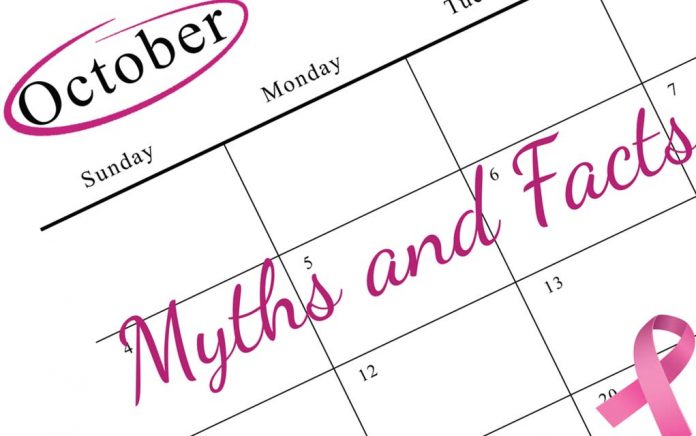
WHOA! Common Cancer Myths DEBUNKED — What YOU Need to Know
(AscendHealthy.com) – In recent years, many of us have become more knowledgeable about breast cancer. We may wear pink ribbons to show our awareness of this disease (especially during the month of October in honor of Breast Cancer Awareness Month), participate in breast cancer events, and perhaps even team up with friends for annual mammograms. But all those efforts haven’t banished certain breast cancer myths. Let’s separate the myths from the facts in the article below.
Myth: Breast Cancer Is the Most Common Cancer
Fact: Breast cancer ranks second for common cancers in women in the United States, with skin cancer taking first place. Lung cancer, followed by breast cancer, is the most common cause of cancerous deaths for women, according to the American Cancer Society.
For men, the most common forms of cancer are prostate and lung cancer. While prostate cancer is the top cancer risk, lung cancer more frequently results in death for men.
Myth: Men and Women Have the Same Breast Cancer Symptoms
Fact: Although we might assume that both genders have the same signs of breast cancer, certain symptoms are gender-specific.
Women should check with their doctor if they have any of these symptoms:
- A lump in their breast
- Changes including breast appearance, shape, and size
- A nipple that becomes inverted
- Breast skin differences such as dimpling, flaking or pitting
Men should visit their healthcare provider for any of these symptoms:
- Discharge from their nipple
- Swelling or lumps
- Flaky skin or red areas
- Breast skin irritations or dimpling
- Nipple pain
- Pulled-in nipple
Myth: Men and Women Have Identical Breast Cancer Risk Factors
Fact: Just as with symptoms, men and women have some different breast cancer risk factors. Having one or more of those risk factors doesn’t necessarily mean we will be diagnosed with breast cancer. And the reverse is true, too: Some people with no risk factors develop this disease.
For women, breast cancer risk factors include:
- Getting older
- Being a woman
- Exposure to radiation as a young adult or youth
- Obesity
- Starting menstruation before age 12
- Giving birth to your first baby after 30
- Never becoming pregnant
- Hormone therapy for menopause
- Alcohol consumption
For men, breast cancer risk factors include:
- Getting older
- Family history
- Klinefelter’s syndrome, which results from male infants having more than one copy of the X chromosome. This syndrome causes men to develop more female hormones and fewer male hormones.
- Liver disease
- Obesity
- Testicle surgery or disease
Myth: Men and Women With Family Histories of Breast Cancer Always Develop It
Fact: Having a sibling, parent, or offspring with breast cancer doesn’t necessarily mean we will develop that form of cancer. Most individuals with breast cancer do not have that disease in their family history.
You may have heard of breast cancer gene 1, known as BRCA1, and breast cancer gene 2, referred to as BRCA2. These are gene mutations that may increase our risk. However, health professionals link only 5 to 10 percent of breast cancer diagnoses to these gene mutations.
Myth: Mammograms Always Detect Breast Cancer
Fact: Undergoing mammograms to screen for breast cancer began in the 1970s. Many of us feel triumphant when we get the good news that we have no signs of this disease.
But does getting an “all clear” yearly mammogram really guarantee we don’t have breast cancer? Sadly, no.
Tumors may exist in our breasts that don’t show up on a mammogram. Particularly for women with dense breast tissue, MRIs or ultrasounds may offer better alternatives to screen for cancer. Talk with your healthcare provider about any concerns.
Myth: Men and Women Get Different Types of Breast Cancer
Fact: Even though men face breast cancer less frequently (annually, men receive 1 in 100 breast cancer diagnoses), men and women get the same types of breast cancer.
The most frequently diagnosed breast cancers in both men and women include:
- Invasive ductal carcinoma, in which cancer cells develop into different parts of our breast tissue outside the ducts.
- Invasive lobular carcinoma, which may grow into other areas of our bodies.
- Ductal carcinoma in situ (DCIS), which involves cancerous cells in the duct linings.
Myth: All Breast Cancer Treatment Involves Chemotherapy
Fact: Increasingly, oncologists are customizing breast cancer treatment. Rather than always prescribing chemotherapy, for example, these cancer specialists may suggest drug therapy.
Depending on the breast cancer type and whether it has spread into other areas of our body, the oncologist alternatively may recommend surgery, radiation therapy, hormone therapy, or immunotherapy.
Whether we are male or female, just the words “breast cancer” may make us apprehensive. But by understanding more about this disease, we can take charge of our health.
Recognizing breast cancer symptoms and the ability to separate myths from facts may go a long way in helping us feel empowered. If you have any concerns about your risk factors or family history or if you’re experiencing breast cancer symptoms, talk with your doctor for guidance.
~Here’s to Your Healthy Ascension
Copyright 2024, AscendHealthy.com




















